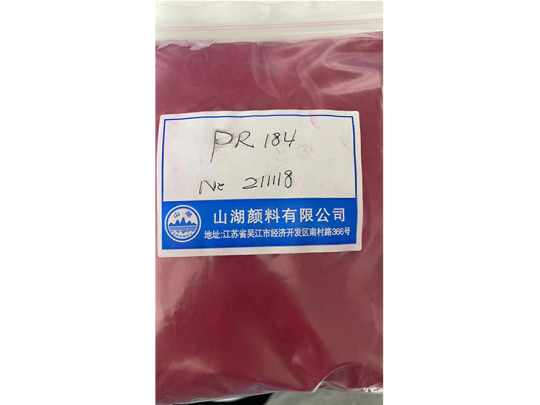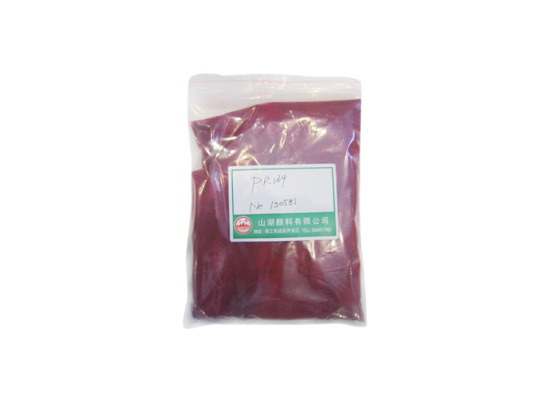Sanhu Color Co., Ltd was founded in 1995. For almost 20 years, we are specializing in developing and producing organic pigments, Registered brand ”SANHU” pigments are world-famous. Pigment Violet 3 & Pigment Red 81 are produced and inspected by advanced technology and equipment and used in kinds of Industrial areas. Sanhu pigments are famous for their stable quality and production capacity. Over 90% of pigments are exported. https://www.shanhucolor.com/
Don't wanna be here? Send us removal request.
Text
Pigment Red 184
Product name
C.I.Pigment Red 184
CAS: 99402-80-9
C32H25ClN4O4
12487; C.I.Pigment Red 184; P.R.184; Naphthol Rubine F6B; Permanent Rubine F6G;
Pigment Red 184 Physical and Chemical Properties
Hue or color light: Blue Red
Relative density: 1.35-1.40
Bulk density / (LB / gal): 11.2-11.6
Melting point / ℃: 320-330
Average particle size/ μ m: 0.10-0.12
Particle shape: small thin flake pigments red
Specific surface area / (m2 / g): 38-42
PH / (10% slurry): 5
Hiding power: translucent
Pigment Red 184 Application
The pigment is similar to C.I. Pigment Red 146 in color light, application performance, and chemical structure. It belongs to the modified product of C.I. Pigment Red 146. It is mainly used for printing ink. Its sample is resistant to soap, paraffin, dibutyl phthalate, toluene, etc; The lightfastness is 1 grade higher than that of C.I. Pigment Red 57:1; Excellent solvent resistance makes it suitable for all kinds of printing inks, such as packaging printing ink, flexo printing ink, and metal decoration printing ink. The heat stability is 170 ℃ / 10min, but it is not resistant to sterilization. There are 25 commodity brands on the market.

0 notes
Text
Pigment Red 169
Product name
C.I. Pigment Red 169
CAS 12237-63-7
CuFe(CN)6
45160: 2; C.I. Pigment Red 169;
Pigment Red 169 Physical Properties
Hue or color light: brilliant blue and red
Relative density: 1.47-2.20
Bulk density / (LB / gal): 12.2-18.3
Specific surface area / (m2 / g): 89-92
PH / (10% slurry): 6.0
Oil absorption / (g / 100g): 55-92
Hiding power: transparent
Pigment Red 169 Application
The natural organic pigments variety gives pure blue light red, which meets the color requirements of three-color or four-color printing ink. The specific surface area of argillite red FB is 89m2 / g. It is mainly used for printing ink, especially toluene gravure printing ink and water-based soft printing ink, and can be used for color matching with C.I. Pigment Red 57:1; Sometimes due to the content of copper ferricyanide, the processing characteristics of printing ink are affected. There are 17 commodity brands on the market.

0 notes
Text
Pigment Red
Red has been available to artists since prehistory in the form of red earth, but throughout art history, the color red has often been characterized by pigments with poor lightfastness and high toxicity. The poisonous Vermillion was made using mercury sulfide, and it was the predominant red pigment used by European artists from the Renaissance to the 20th Century. Alongside Vermillion were dye-based lake pigments like Carmine, Rose Madder, and, more recently, Alizarin Crimson, which are prone to fading. The faces in early Renaissance paintings sometimes have a distinctly green hue, due to the use of a thin layer of fugitive red which has faded to reveal the highly lightfast green earth underpainting. The 19th and 20th centuries saw the development of the Cadmium, Azo, Pyrrole, Quinacridone, and Benzimidazolone pigment groups, and today the red pigment family is one of the largest.
Pigment Red Comparison
Product Name
(pigment)
Color shade
(Color index N)
Physical data fastness properties
(Full shade)
recommended
(int)
Light Fast Pink Toner
P.R.81
Light Fast Pink Toner B
P.R.8:1
Light Fast Pink Toner -1
P.R.8:2
Light Fast Pink Toner B-l
P.R.8:3
Light Fast Pink Lake
P.R.8:5
Light Fast Pink Toner SH-CF
P.R.169

0 notes
Text
Pigment Blue 1
Product name
C.I.PIGMENT BLUE 1 C.I. 42595:2
CAS NO: 1325-87-7
C33H40N3
Pigment Violet 3; Light Fast Violet Lake
Pigment Blue 1 Physical and Chemical Properties
Density(g/cm³): 1.77-1.84
Light:4 Grade
Heat(℃): 140
Water Resistance: 4 Grade
Acid: 5 Grade
Alkali: 4 Grade
Pigment Blue 1 Application
[4-[[4-(Diethylamino)phenyl][4-(ethylamino)-1-naphthalenyl]methylene]-2, 5-cyclohexadien-1-ylidene]-N-ethylethanaminiummolybdatetungstatephosphate; c.i.42595:2; PEACOCKBLUE; Ethanaminium, Chemical bookN-4-4-(diethylamino)phenyl4-(ethylamino)-1-naphthalenylmethylene-2, 5-cyclohexadien-1-ylidene-N-ethyl-, molybdatetungstatephosphate; Cas cade Blue; C.I.PIGMENT BLUE1; Blue6390; 4235FastBlueLakeBO

0 notes
Text
Pigment Blue 14
Product name
C.I. Pigment Blue 14
CAS:1325-88-8
C31H42N3·x
C.I. Pigment Blue 14; Pigment blue 14 (C.I. 42600:1)
Pigment Blue 14 Physical and Chemical Properties
Hue or color light: bright red light blue
Pigment Blue 14 Synonyms
C.I. Pigment Blue 14;
Pigment blue 14 (C.I. 42600:1)
Pigment Blue 14 Application
The pigment is a Phosphotungsten molybdic acid lake of substituted triaminotriphenylmethane basic dyes, which is only produced in the United States and gives a stronger red and blue light. Like C.I. Pigment Blue 2 and C.I. Pigment Blue 9, this product has little industrial value and the market is gradually shrinking. It is mainly used for coloring special cultural and educational supplies and printing ink.

0 notes
Text
Pigment Blue
Pigment blue is one of the oldest pigments known to mankind. It is widely used in food, medicine, printing, and dyeing industries. The application of indigo as a fabric dye can be traced back to at least 2500 BC. Some clothes worn by ancient Egyptian mummies and blue linen fabrics unearthed from Mawangdui in China are dyed with indigo. A branch of Yao nationality in China is named "blue indigo Yao" because of its unique technology of producing and using indigo-dyed cloth.

0 notes
Text
Organic Pigments
Organic Pigments refer to a kind of pigment made of organic compounds with color and a series of other pigment characteristics.
Compared with ordinary inorganic pigments, organic pigments usually have high coloring power. The particles are easy to grind and disperse, not easy to precipitate, and the color is bright, but the sun resistance, heat resistance, and weather resistance are poor.
Organic pigments are widely used in the coloring of inks, coatings, rubber products, plastic products, cultural and educational supplies, building materials, and other materials.
Organic Pigments List
Pigment Red
Pigment Red
Organic Pigment Red can be divided P.R. 81,81:1,81:2,81:3,81:5,169,268,269 and so on, is widely used in inks, paints, coatings, raw pulp coloring of synthetic fibers, pigment printing of fabrics, the coloring of plastics, rubber, and leather, among which the use of ink pigments is the largest.
Pigment Red
Pigment Red 184
Pigment Red 210
Pigment Red 81
Pigment Red 269
Pigment Red 169
Pigment Red
Pigment Violet
Pigment Violet
Organic Pigment Violet can be divided into P.V. 1,2,3 and so on, is widely used in inks, paints, coatings, raw pulp coloring of synthetic fibers, pigment printing of fabrics, the coloring of plastics, rubber, and leather, among which the use of ink pigments is the largest.
Pigment Violet
Pigment Violet 1
Pigment Violet 2
Pigment Violet 3
Pigment Violet
Pigment Blue
Organic Pigment Blue can be divided P.B. 1,10,14,62 and so on, is widely used in inks, paints, coatings, raw pulp coloring of synthetic fibers, pigment printing of fabrics, the coloring of plastics, rubber, and leather, among which the use of ink pigments is the largest.

1 note
·
View note